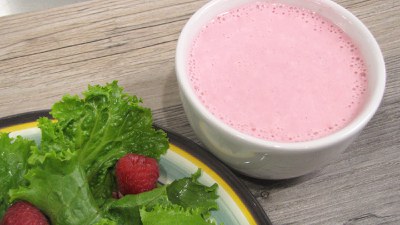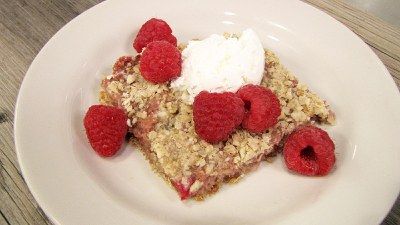Field to Fork Raspberries! (FN1797, Reviewed Jan. 2020)

Growing
Raspberry plants should be planted in early spring. Summer- and fall-bearing varieties are available. Plant raspberries at least 2 feet apart in rows that are spaced 6 to 8 feet apart. As time passes, prune to allow six to eight canes per hill for optimal yield.
See the NDSU Extension Service publications “Starting a Community Orchard in North Dakota” (H1558) and “Refreshing Raspberries” (H38) for more information.
Storage
Use ripe raspberries right away, and throw away any moldy or damaged berries. Store raspberries in the crisper in your refrigerator at 40 F. Try to use the berries within two days after purchase or picking to ensure freshness. Rinse them right before use.
Preservation
Raspberries may be frozen, canned or dried.
Freezing: Raspberries can be frozen in various ways.
Unsweetened pack: Place berries on a tray and place in the freezer. As soon as they are frozen, pack into containers in recipe-size amounts, leaving ½ inch head space. Seal, label with the contents and date, and freeze. Raspberries also may be placed directly into freezer containers or bags and frozen.
Sugar pack: To 1 quart (1a pounds) berries, add ¾ cup sugar and mix carefully. Put into containers, leaving ½ inch head space. Seal, label and freeze.
See the NDSU Extension Service publication “Freezing Fruits” (FN182) for more information.
Canning: Choose ripe but firm, sweet berries with uniform color. Wash 1 or 2 quarts of berries at a time; drain and stem. Prepare syrup if desired (see reference below). Bring syrup to a boil and reduce heat. Spoon prepared berries into hot, clean jars, leaving ½ inch head space. Lightly shake the jars to pack the berries closely (do not crush). Return syrup to boiling. Add the boiling syrup to cover the berries, leaving ½ inch head space. Wipe jar rims and add lids. Process hot-packed berries in pints or quarts in a boiling water-bath canner: 15 minutes (0 to 2,000 feet altitude) or 20 minutes (more than 2,000 feet altitude).
See the NDSU Extension publication “Home Canning Fruit and Fruit Products (FN174) for more information.
Drying: Learn how to make raspberry fruit leather in the NDSU Extension Service publication “Making Fruit Leathers” (FN1586).
Nutrition
Without added sugar, 1 cup of raspberries has 64 calories, 1 gram (g) fat, 1.5 g protein, 15 g carbohydrate, 8 g fiber and 1 milligram sodium. Raspberries also contain potential cancer-fighting natural plant chemicals, including ellagic acid.
Recipes

Raspberry Salad Dressing
In a blender, combine the yogurt, raspberries, vinegar and sugar. Blend until smooth and refrigerate until chilled.
Makes eight servings. Each serving has 35 calories, 0 g fat, 2 g protein, 7 g carbohydrate, 2 g fiber and 25 mg sodium.
Raspberry Jam
Half-fill water-bath canner with hot water; place it on the stove and let the water come to a boil while preparing jam. Crush the raspberries with a potato masher. Mix the raspberries and pectin and heat to boiling, stirring constantly. Add the sugar all at once and stir until dissolved. Continue stirring gently until the mixture comes to a full rolling boil that cannot be stirred down. Start timing for one minute and stir constantly while it continues to boil. Remove from heat. Skim any foam from the jam, and carefully ladle the jam into clean jars using a canning funnel. Fill jars to within ¼ inch of the rim. Wipe the rim with a clean, damp cloth. Quickly apply the lid and fasten with a ring. Process for 10 minutes (when water begins to boil again, start timing) in a boiling-water bath.
Makes eight servings. Each 1-tablespoon serving has 45 calories, 0 g fat, 0 g protein, 12 g carbohydrate, 0 g fiber and 0 mg sodium.

Raspberry Applesauce Squares
Crust/Crumb Topping
Filling
Preheat oven to 375 F. Grease a 9- by 13-inch baking pan. Combine oats, brown sugar and butter using a pastry blender. Add flour and continue combining, using a pastry blender, until crumbly. Spread half the crumb mixture into the bottom of the prepared baking pan. Bake in preheated oven until crust is lightly browned, about 20 minutes. Remove from oven and cool.
Mix raspberries, applesauce, oat bran and white sugar together in a bowl. Spread the raspberry filling onto the cooled crust and sprinkle with remaining crumb topping. Bake until topping is lightly browned, about 20 more minutes.
Makes 12 servings. Each serving has 330 calories, 15 g fat, 3 g protein, 46 g carbohydrate, 5 g fiber and 105 mg sodium.
Key to abbreviations
c. = cup oz. = ounce
tsp. = teaspoon g = gram
Tbsp. = tablespoon mg = milligram
Funding for this publication was made possible by the U.S. Department of Agriculture’s Agricultural Marketing Service through grant AM170100XXXXG005.
Its contents are solely the responsibility of the authors and do not necessarily represent the official views of the USDA.
For more information on this and other topics, see www.ag.ndsu.edu
County commissions, North Dakota State University and U.S. Department of Agriculture cooperating. NDSU does not discriminate in its programs and activities on the basis of age, color, gender expression/identity, genetic information, marital status, national origin, participation in lawful off-campus activity, physical or mental disability, pregnancy, public assistance status, race, religion, sex, sexual orientation, spousal relationship to current employee, or veteran status, as applicable. Direct inquiries to Vice Provost for Title IX/ADA Coordinator, Old Main 201, NDSU Main Campus, 701-231-7708, ndsu.eoaa@ndsu.edu. This publication will be made available in alternative formats for people with disabilities upon request, 701-231-7881. 2.5M-1-20

